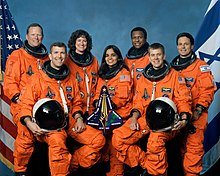The year 2003 marked a dark chapter in the history of space exploration. On February 1st, the world watched in shock and disbelief as the Space Shuttle Columbia disintegrated upon re-entering Earth’s atmosphere, bringing an abrupt end to the STS-107 mission. This devastating event resulted in the loss of all seven brave astronauts on board, leaving a profound impact on NASA and the future of space exploration.
The Columbia disaster was caused by a critical flaw that occurred during the shuttle’s launch. A piece of foam insulation, weighing just a few pounds, broke off from the shuttle’s external tank and struck the left wing. This seemingly minor incident would prove to have catastrophic consequences.
As the shuttle re-entered the Earth’s atmosphere, the damaged wing allowed hot gases to penetrate the orbiter’s structure, leading to the disintegration of the vehicle. Debris from the disintegration scattered across several states, leaving a trail of destruction and shock in its wake.
The loss of the Columbia and its crew was a wake-up call for NASA and the entire space exploration community. It exposed vulnerabilities in the shuttle program and highlighted the need for a comprehensive reassessment of safety protocols. The incident prompted a 29-month suspension of the shuttle program, during which time NASA conducted an exhaustive investigation to determine the cause of the disaster.
The investigation revealed that NASA had become complacent in its approach to safety. The foam insulation that caused the fatal damage had been a known issue for years, but it was dismissed as a minor concern. The disaster forced NASA to confront the reality that even seemingly insignificant flaws can have catastrophic consequences in the unforgiving environment of space.
The Columbia disaster also exposed systemic communication failures within NASA. Engineers had observed the foam strike during the shuttle’s launch but failed to recognize the severity of the damage. The lack of effective communication channels between different departments and teams within the organization contributed to the tragedy.
The findings of the investigation led to a complete overhaul of NASA’s safety protocols and a renewed focus on preventing similar incidents in the future. The shuttle program was redesigned, with enhanced safety measures and stricter adherence to pre-launch inspections and procedures. NASA also established a new office dedicated to safety oversight, ensuring that lessons learned from the Columbia disaster would be implemented and followed rigorously.
Despite the tragedy and the changes it brought about, the Columbia disaster served as a poignant reminder of the inherent risks involved in space exploration. The brave men and women who venture into the unknown do so knowing the dangers they face. Their sacrifice is a testament to the human spirit of exploration and the pursuit of knowledge.
Today, as we reflect on the events of that fateful day in 2003, we pay tribute to the crew of the Space Shuttle Columbia: Commander Rick D. Husband, Pilot William C. McCool, Mission Specialist Michael P. Anderson, Mission Specialist Ilan Ramon, Mission Specialist Kalpana Chawla, Mission Specialist David M. Brown, and Payload Specialist Laurel B. Clark. Their legacy lives on in the advancements and improvements made to space exploration, ensuring that their sacrifice was not in vain.
The 2003 Space Shuttle Columbia disaster was a turning point in the history of space exploration. It forced NASA and the world to confront the risks and challenges of venturing beyond Earth’s atmosphere. The lessons learned from this tragedy continue to shape the future of space exploration, ensuring that safety and meticulous attention to detail remain at the forefront of every mission.
SEO Excerpt:
The 2003 Space Shuttle Columbia disaster was a tragic event that occurred on February 1, 2003. The disintegration of the shuttle upon re-entry resulted in the loss of all seven astronauts on board. This disaster was caused by a piece of foam insulation breaking off from the shuttle’s external tank and striking the left wing during launch. The incident led to a thorough investigation and a 29-month suspension of the shuttle program. It served as a wake-up call for NASA, prompting a reevaluation of safety protocols and a renewed focus on preventing future incidents. The Columbia disaster remains a somber reminder of the risks involved in space exploration.

